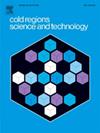考虑多年冻土退化的桥梁桩基竖向承载力研究
IF 3.8
2区 工程技术
Q1 ENGINEERING, CIVIL
引用次数: 0
摘要
本研究通过承载力试验,定量分析冻土退化对铁路桥梁桩基竖向承载力的影响。同时,建立了考虑冻土退化的桩基竖向承载力预测模型,并通过试验进行了验证。研究结果表明,冻土带退化对桩基和周围土体的破坏形态均有显著影响。随着多年冻土退化的加剧,桩基及周围土体的破坏日益明显。随着冻土退化程度的加剧,桩基竖向极限承载力和最大侧摩阻力均呈现明显的下降趋势。冻土条件下桩基竖向极限承载力比冻土厚度为160 cm时降低20.1%,最大侧摩阻力降低13.2%。而多年冻土退化对桩基最大端部承载力的影响较小。然而,随着多年冻土退化程度的加剧,桩基最大端承载力所占比例增加。桩基回弹率随冻土厚度的减小而减小。结果表明,该预测模型能较好地预测多年冻土退化对桩基竖向承载力的影响。本文章由计算机程序翻译,如有差异,请以英文原文为准。
Study on vertical load-bearing capacity of bridge pile foundation considering permafrost degradation
This study conducted load-bearing capacity tests to quantitatively analyze the impact of permafrost degradation on the vertical load-bearing capacity of railway bridge pile foundations. Meanwhile, a prediction model of vertical load-bearing capacity for pile foundations considering permafrost degradation was developed and validated through these tests. The findings indicate that the permafrost degradation significantly influences both the failure patterns of the pile foundation and the surrounding soil. With the aggravation of permafrost degradation, damage to the pile foundation and the surrounding soil becomes more pronounced. Furthermore, as permafrost degradation aggravates, both the vertical ultimate bearing capacity and maximum side friction resistance of pile foundations exhibit a significant downward trend. Under unfrozen soil conditions, the vertical ultimate bearing capacity of pile foundations is reduced to 20.1 % compared to when the permafrost thickness is 160 cm, while the maximum side friction resistance drops to 13.2 %. However, permafrost degradation has minimal impact on the maximum end bearing capacity of pile foundations. Nevertheless, as permafrost degradation aggravates, the proportion of the maximum end bearing capacity attributed to pile foundations increases. Moreover, the rebound rate of pile foundations decreases with decreasing permafrost thickness. Finally, the results confirm that the proposed prediction model can demonstrates a satisfactory level of accuracy in forecasting the impact of permafrost degradation on the vertical load-bearing capacity of pile foundations.
求助全文
通过发布文献求助,成功后即可免费获取论文全文。
去求助
来源期刊

Cold Regions Science and Technology
工程技术-地球科学综合
CiteScore
7.40
自引率
12.20%
发文量
209
审稿时长
4.9 months
期刊介绍:
Cold Regions Science and Technology is an international journal dealing with the science and technical problems of cold environments in both the polar regions and more temperate locations. It includes fundamental aspects of cryospheric sciences which have applications for cold regions problems as well as engineering topics which relate to the cryosphere.
Emphasis is given to applied science with broad coverage of the physical and mechanical aspects of ice (including glaciers and sea ice), snow and snow avalanches, ice-water systems, ice-bonded soils and permafrost.
Relevant aspects of Earth science, materials science, offshore and river ice engineering are also of primary interest. These include icing of ships and structures as well as trafficability in cold environments. Technological advances for cold regions in research, development, and engineering practice are relevant to the journal. Theoretical papers must include a detailed discussion of the potential application of the theory to address cold regions problems. The journal serves a wide range of specialists, providing a medium for interdisciplinary communication and a convenient source of reference.
 求助内容:
求助内容: 应助结果提醒方式:
应助结果提醒方式:


